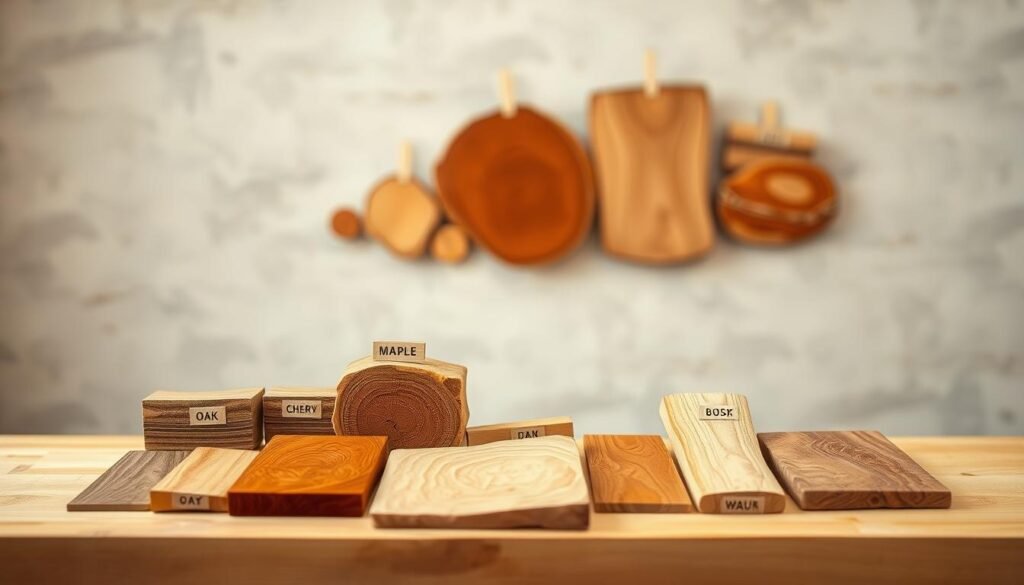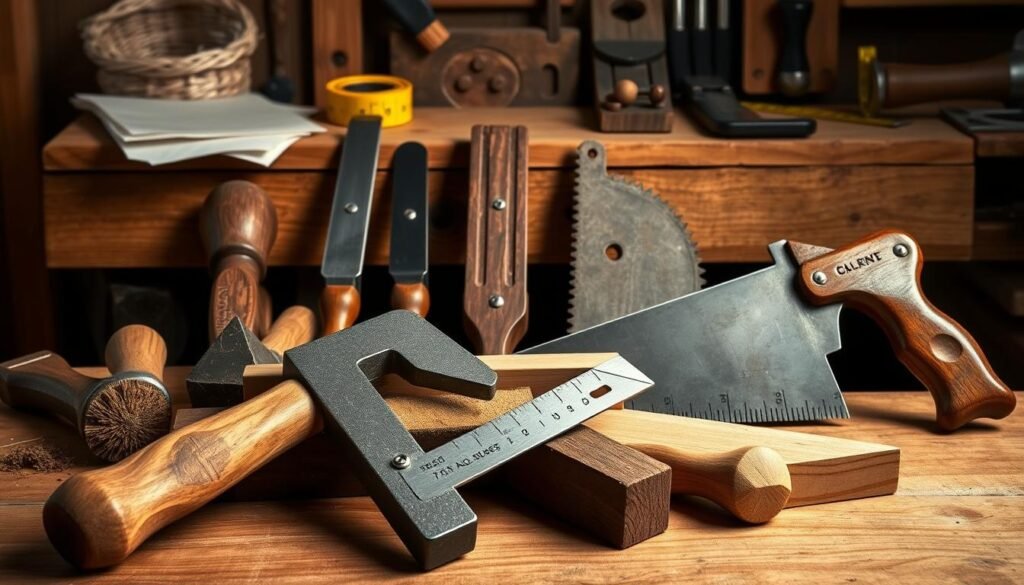Welcome to the world of woodworking, where creativity meets craftsmanship. For beginners, mastering the basics is the first step towards creating something truly remarkable.
Understanding woodworking basics is key for any maker. It’s important for bringing projects to life. Whether you’re making furniture or decorative items, the right woodworking techniques are vital.
As you start your woodworking journey, you’ll find many woodworking projects for beginners. These projects help you improve your skills. With practice and patience, you’ll be ready for more complex projects and learn useful woodworking tips and tricks.
Woodworking Safety: The Foundation of Every Project
The heart of woodworking isn’t just about the tools or how you use them. It’s about keeping yourself safe. A safe workspace is key for your projects’ success and your health. Woodworking safety rules help avoid accidents and let you enjoy your hobby safely.
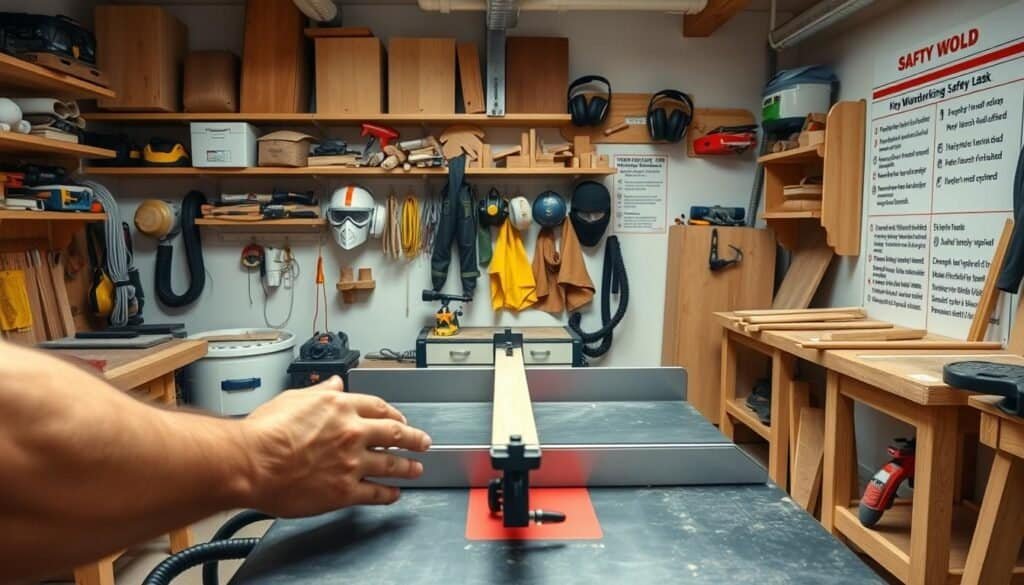
First, learn the basics of woodworking and how safety fits into it. Wear the right protective gear, like safety glasses and ear protection. Also, make sure your workspace is clean and free from clutter.
Emergency Procedures and First Aid
Even with safety in mind, accidents can happen. Knowing what to do in emergencies is vital. It’s important to know basic first aid and have a first aid kit ready. Everyone in the woodworking area should know the emergency procedures.
Important safety steps include knowing how to turn off tools quickly, having a fire extinguisher nearby, and staying alert. By focusing on safety and being ready, you can lower accident risks and have a safer woodworking time.
Setting Up Your Woodworking Space
Setting up your woodworking space right can make your DIY projects better. A tidy workshop boosts your work speed and keeps you safe.
First, check how much space you have and plan your layout. Think about how you’ll move around and use your space best. In small areas, use the walls to save floor space.
Space-Saving Solutions for Small Workshops
In small workshops, saving space is key. Use wall-mounted tool holders and foldable workbenches to free up floor space.
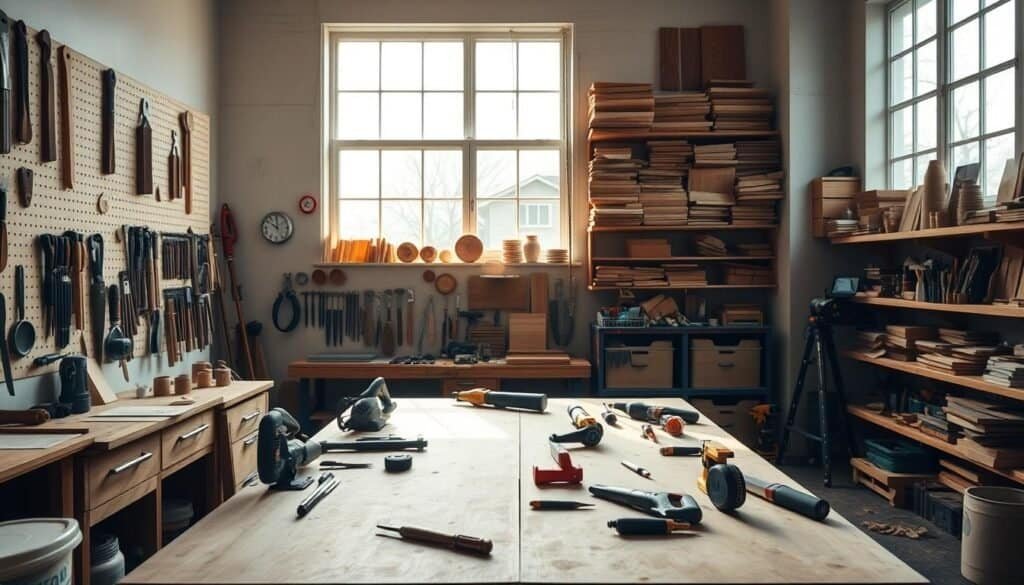
Organizing your tools is also important. Use bins and labeled containers to keep them handy but not in the way. This makes it easier to focus on your projects.
With these tips, you can make a great woodworking space, even in small areas. This setup will make your woodworking better and encourage you to do more projects.
Measuring and Marking: Precision is Key
Getting woodworking projects right starts with precise measuring and marking. This ensures wood pieces fit perfectly together. It also cuts down on errors that waste material and time.
Woodworkers use tools like calipers, micrometers, and marking gauges for accuracy. These tools help measure and mark wood accurately. This makes joints and cuts precise and clean.

Templates are key in precision woodworking. They help woodworkers make parts the same way, ensuring consistency. By using a template, woodworkers can mark wood accurately and quickly. This saves time and reduces mistakes.
Making a template involves designing and crafting a pattern. This pattern is used to mark or cut wood. It’s very useful for complex or repetitive cuts where precision is essential.
Essential Woodworking Techniques Every Maker Should Know
Woodworking techniques are key to any successful project. They let makers turn their ideas into reality. It’s not just about following steps; it’s about knowing the reasons behind each action.
Measuring and marking accurately is a basic skill. It makes sure pieces fit right, saving time and reducing waste. Knowing when to use tools like table saws or jigsaws is also important.
Estimating Materials and Costs
Before starting a project, figuring out materials and costs is essential. Makers need to plan out their project and list all needed materials. This includes wood, nails, screws, glue, and finishes.
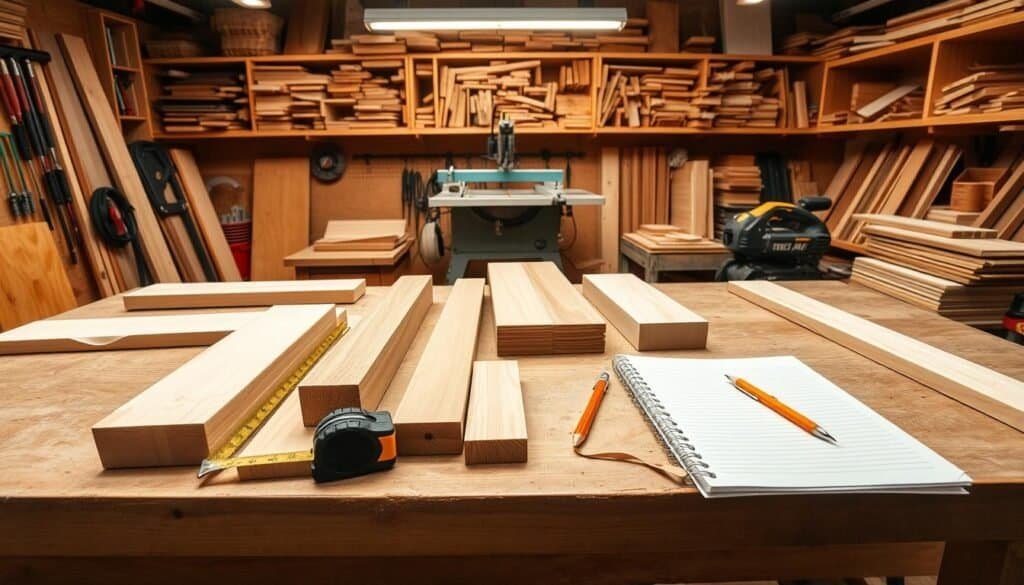
To estimate costs, makers should look up current prices. Adding a little extra to the estimate helps cover unexpected costs. This way, makers can stay within their budget and enjoy their projects more.
Good material planning helps with cost and waste. It’s good for your wallet and the planet. By planning well, woodworkers can finish projects on time and within budget, making the process more fun.
Cutting Techniques: Making Clean and Accurate Cuts
Making clean cuts is a key skill for woodworkers. It doesn’t matter if you’re new or have lots of experience. The quality of your cuts affects how your projects look.
Choosing the right tools for cutting is important. You need different tools for different cuts. For example, table saws are best for straight cuts, while miter saws are for angled cuts. Knowing what each tool does helps you make precise cuts.
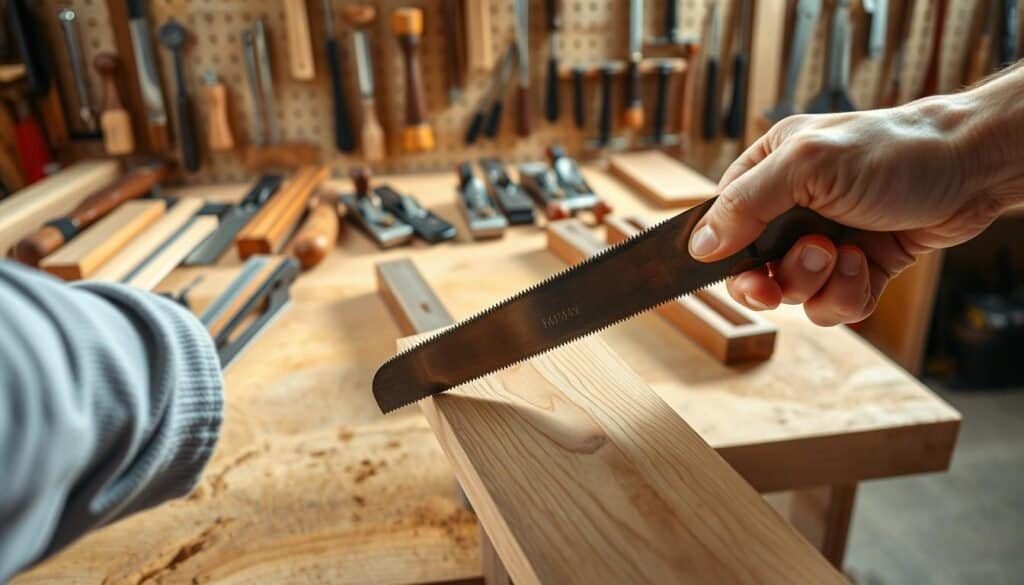
Tearout and splintering can ruin your projects. To avoid these, use the right tools and techniques. A sharp blade with lots of teeth can help with tearout. Also, make sure the wood is supported to prevent splintering.
Using a zero-clearance insert on your table saw helps too. It supports the wood, reducing tearout. For small, delicate cuts, a scoring cut before the final cut can prevent splintering.
Learning different cutting techniques and how to avoid common problems can make your work look professional. Whether it’s a small project or a big piece of furniture, clean cuts are essential for quality woodworking.
Joinery Methods: Connecting Wood Pieces
Learning about joinery methods is key for woodworkers. It helps make pieces that last and look great. Joinery techniques give a piece its strength, making it last for years.
There are many joinery methods, each with its own use and benefits. The dovetail joint is strong and good for drawers and cabinets. The mortise and tenon joint is strong and versatile, used in many projects like furniture and framing.
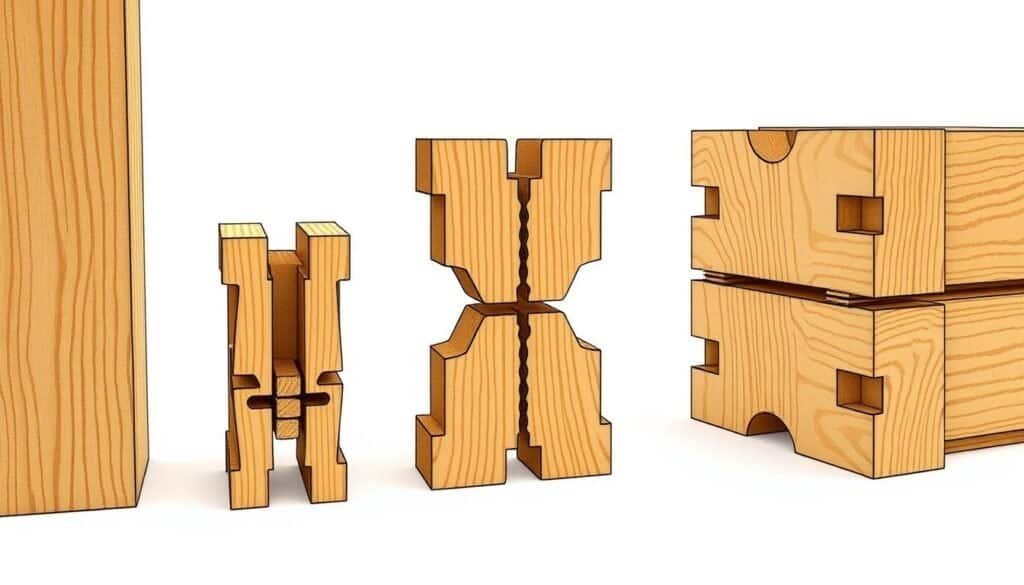
It’s important to strengthen joints for better durability. Using dowels, splines, or mechanical fasteners can help. For example, a spline in a miter joint makes it stronger against stress and strain.
Also, the right adhesive and clamping can make joints last longer. Knowing when and how to strengthen joints is essential for lasting woodwork.
In summary, mastering joinery methods and knowing how to reinforce them is vital. By using both old and new techniques, woodworkers can create pieces that are both functional and beautiful.
Sanding and Surface Preparation
A well-prepared surface is key to a successful woodworking project. Sanding is the first step. It makes the wood surface smooth and even, ready for finishing.
Choosing the right sanding tools is essential. Start with coarse grits like 80 or 100, then move to finer grits like 220 or 240. This ensures a thorough sanding process.
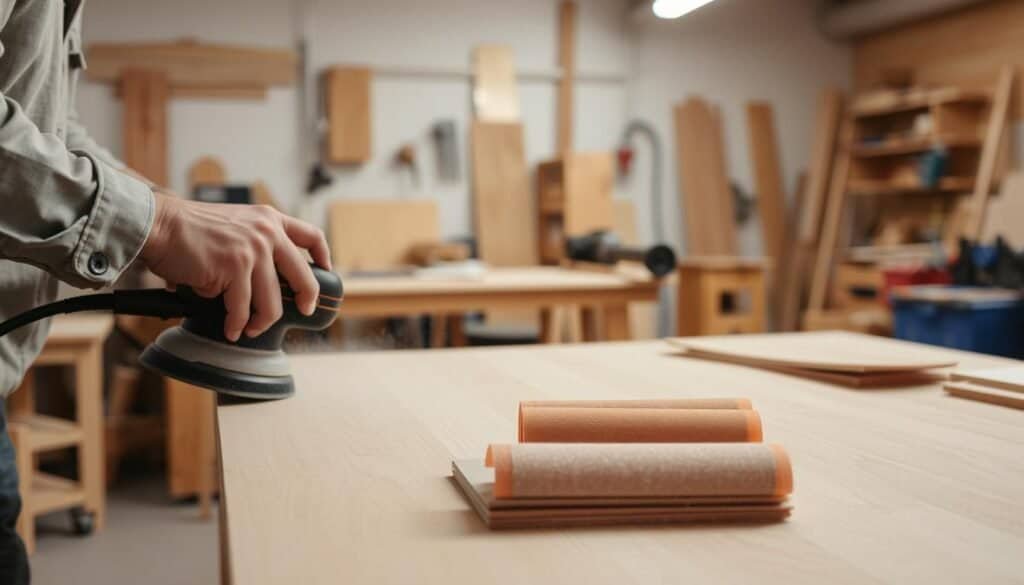
Dents, scratches, and other imperfections can be tough to fix. For small dents, wood filler can help. For scratches, sanding with a fine grit sandpaper along the grain can remove them. Always check the surface under good lighting to catch any remaining imperfections.
Cleaning the surface after sanding is also important. Use a tack cloth or a vacuum with a brush attachment to remove dust and debris. By focusing on sanding and surface preparation, woodworkers can get professional-looking results.
Finishing Techniques: Protecting and Beautifying Your Work
Choosing the right finishing techniques is key to protecting and beautifying wood. These techniques highlight the wood’s natural grain and texture. They also add a protective layer against damage.
Woodworkers have many finishing techniques to choose from. Oil-based finishes are known for their durability and easy application. Water-based finishes, on the other hand, dry quickly and have a low odor.
Creating Custom Finishes and Effects
Creating custom finishes and effects can add a personal touch to projects. Techniques like distressing, staining, and applying multiple layers can create unique and beautiful effects.
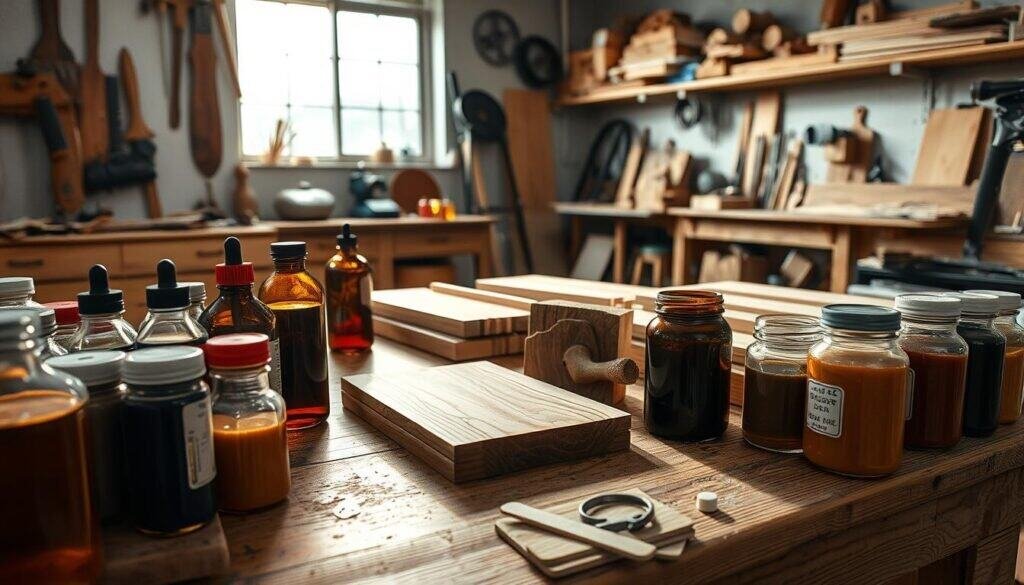
When picking a finish, consider the wood type and project use. For example, polyurethane is great for furniture due to its protective qualities.
Trying out different techniques and products can help achieve the desired look and protection. Whether you want a rustic or modern finish, the right techniques can make a big difference.
Advanced Woodworking Skills to Develop
Improving your woodworking means learning advanced techniques. These skills add a new level of artistry to your work. As you grow, you’ll want to tackle more complex and creative projects.
Inlay work is a key skill to master. It involves embedding materials like wood, metal, or stone into a base. This creates detailed designs or patterns. It’s precise and requires patience but makes your projects stand out.
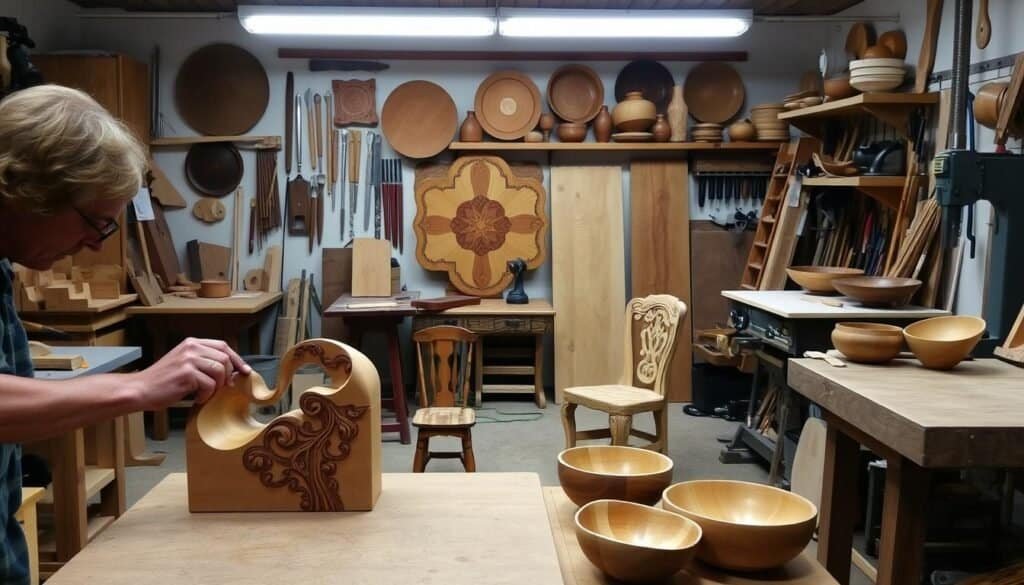
Veneering is another advanced technique. It uses thin wood layers on a base to achieve a look. This way, you can use expensive woods without the full cost.
Decorative techniques like carving, marquetry, and detailed joinery also enhance your work. They add beauty and show off your skill.
Learning these advanced skills lets you be more creative. You’ll make pieces that are both beautiful and functional. Whether it’s furniture or decorative items, these techniques will take your work to the next level.
Conclusion: Building Your Woodworking Journey
Starting a woodworking journey is a rewarding path. It needs patience, dedication, and practice. You’ve learned the basics, but keep improving your skills.
Every project is a chance to learn and get better. Joining the woodworking community is key. You’ll find support, inspiration, and new ideas online or in local clubs.
Use what you’ve learned to make beautiful pieces. Stay committed, and your skills will grow. Woodworking offers endless opportunities, and your journey is just starting.


